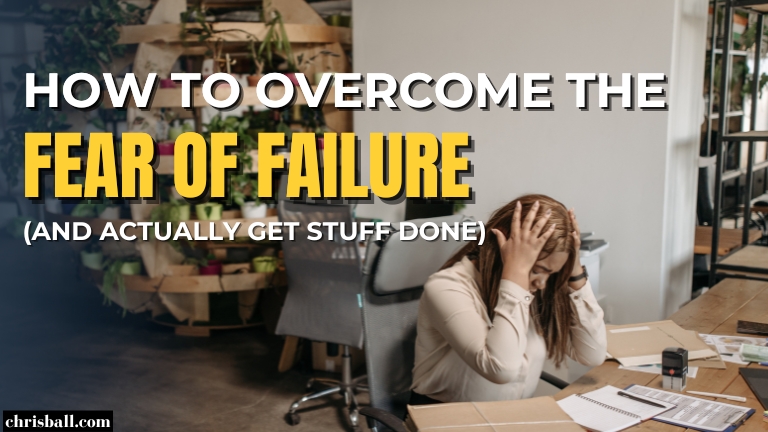Ever spent an entire afternoon rearranging your sock drawer to avoid starting a tricky project? You know exactly what I mean. Your brain is sneaky like that. One minute, you’re about to dive in—then suddenly, you’re knee-deep in mismatched socks. Why? Often, it’s fear. Fear of messing up. Fear of embarrassment. Fear that things won’t turn out perfectly.
Let’s get real: fear of failure is the silent assassin behind most procrastination. It quietly convinces you that doing nothing is safer than messing up. But here’s the good news: you can fight back. I’m about to show you exactly how to beat this fear, turn mistakes into opportunities, and finally get things moving.
First, Stop Taking Failure So Personally
Failure isn’t a permanent label—it’s a single event. You didn’t fail, your attempt did. Think about scientists: their whole job is basically “failing” until something finally clicks. Thomas Edison famously tested over a thousand designs before landing on a working lightbulb. Can you imagine him saying after attempt #997, “That’s it, I quit—candles it is!”?
Next time you stumble, remind yourself: mistakes are just part of the process. They’re signs you’re pushing forward, not backward.
Ask Yourself: What's the Worst That Could Happen?
Seriously, take a second and imagine the absolute worst outcome. Suppose you’re procrastinating on giving a presentation. What’s the absolute worst-case scenario? You mess up, people laugh, and you feel embarrassed, for a bit. Awkward? Sure. World-ending disaster? Not quite.
Imagining the worst outcome usually reveals that fear blows things out of proportion. It deflates anxiety and makes action feel easier. Plus, even in the absolute worst-case scenario, the world keeps turning (trust me—I’ve lived through many cringe-worthy moments!).
Set Tiny, Impossible-to-Fail Goals
Fear of failure loves big, intimidating tasks. It hates tiny, manageable ones. Turn a big task into bite-sized actions you literally can’t fail at. Want to start exercising but keep putting it off? Commit to doing one single push-up each day. One push-up seems silly, right? Exactly. It’s so tiny you can’t say no. Soon, one push-up turns into five, ten, and eventually, an actual workout routine.
Tiny goals trick your brain into action without anxiety. Suddenly, you’re building momentum instead of procrastinating. High five for outsmarting your brain!
Change the Way You Talk About Mistakes
Our inner voice can be pretty brutal. Have you ever called yourself stupid or useless after a slip-up? Harsh self-talk fuels procrastination. It convinces you that mistakes are something to fear.
Try this instead: after a mistake, ask yourself, “What did I just learn?” Even better, say it out loud. Did you mess up a client pitch? Great, you just learned how not to pitch next time. Now you’re smarter and better prepared.
Your inner critic can become your inner coach. Treat mistakes like little clues guiding you toward success.
Celebrate the "Oops" Moments
Yes, you read that right. Celebrate your mistakes. Not with champagne and balloons (unless you really want to), but with acknowledgement. If you screw up, pause and think, “Cool, I took action.” Action beats procrastination any day, even if it’s messy.
Years ago, I sent an important email with an embarrassing typo. Horrified, I waited for ridicule. It never came. Instead, a colleague replied, “Hey, at least we know you’re human!” They laughed, I laughed, and the world kept turning. Celebrate that you’re in the arena, trying things and occasionally stumbling—that’s how progress happens.
Find Your "Failure Role Model"
Everyone loves stories of overnight success, but here’s a secret: those stories are mostly fairy tales. Real-life success stories involve tons of failures along the way.
Take J.K. Rowling—12 publishers rejected “Harry Potter” before someone finally said yes. Imagine if she had quit after rejection #11. Rowling’s story proves that failure isn’t the end. It’s just the messy middle.
Find someone you admire who openly talks about their failures. Use their story to remind yourself that stumbles are stepping stones, not roadblocks.
Build a Habit of Imperfection
Perfectionism is failure’s partner-in-crime. It whispers, “If it’s not perfect, don’t bother starting.” Kick perfectionism to the curb by intentionally doing tasks imperfectly at first.
Got a report due? Write the roughest first draft possible—bad grammar, unfinished thoughts, the whole deal. Making deliberate imperfection your starting point removes pressure. You can always fix it later. Imperfect action beats perfect inaction every time.
Focus on Effort, Not Outcomes
You can’t fully control results. You can control your effort. When facing something scary, ask yourself: “Did I show up? Did I try?” If yes, you’re already winning.
Professional basketball players miss over half their shots, but they keep shooting anyway. Their coaches measure success not just by points scored but by showing up, practising, and making an effort. Copy that playbook: reward yourself for showing up, not just for perfect outcomes.
Be Your Own Science Experiment
Treat your life as a science lab. Each action is an experiment, not a final verdict on your worth. Try something. If it works, great. If not, tweak the method and try again.
I once tried daily jogging at 5 a.m. to boost productivity. Surprise—it was awful. So, I switched to evening jogs and productivity soared. My “failure” at morning running wasn’t a disaster—it taught me what worked better for me.
Get More Help (Totally Free)
Feeling pumped about tackling procrastination and facing failure head-on? Want more practical tools, funny anecdotes, and helpful strategies? You’re in luck.
Subscribe to our newsletter right now and get your free copy of “Overcoming Procrastination.” It’s packed with ideas to help you turn your goals into actions without stress or drama. Plus, it’s free, and free stuff is always awesome.
So why not take one tiny action right now? Subscribe and let future-you thank current-you for finally conquering fear and getting stuff done.
You’ve got this! (And if you don’t—hey, mistakes make the best stories anyway!)
